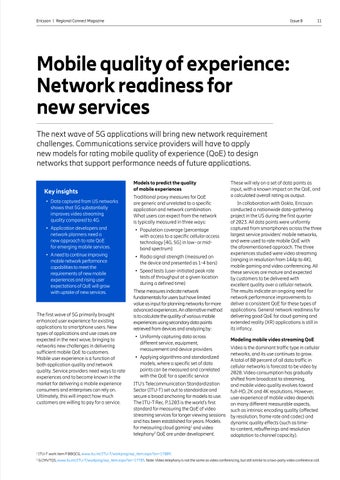Ericsson | Regional Connect Magazine
Issue 8
11
Mobile quality of experience: Network readiness for new services The next wave of 5G applications will bring new network requirement challenges. Communications service providers will have to apply new models for rating mobile quality of experience (QoE) to design networks that support performance needs of future applications.
Key insights
Models to predict the quality of mobile experiences
• Data captured from US networks shows that 5G substantially improves video streaming quality compared to 4G.
Traditional proxy measures for QoE are generic and unrelated to a specific application and network combination. What users can expect from the network is typically measured in three ways:
• Application developers and network planners need a new approach to rate QoE for emerging mobile services.
• Population coverage (percentage with access to a specific cellular access technology [4G, 5G] in low- or midband spectrum)
• A need to continue improving mobile network performance capabilities to meet the requirements of new mobile experiences and rising user expectations of QoE will grow with uptake of new services.
• Radio signal strength (measured on the device and presented as 1-4 bars)
The first wave of 5G primarily brought enhanced user experience for existing applications to smartphone users. New types of applications and use cases are expected in the next wave, bringing to networks new challenges in delivering sufficient mobile QoE to customers. Mobile user experience is a function of both application quality and network quality. Service providers need ways to rate experiences and to become known in the market for delivering a mobile experience consumers and enterprises can rely on. Ultimately, this will impact how much customers are willing to pay for a service.
• Speed tests (user-initiated peak rate tests of throughput at a given location during a defined time) These measures indicate network fundamentals for users but have limited value as input for planning networks for more advanced experiences. An alternative method is to calculate the quality of various mobile experiences using secondary data points retrieved from devices and analyzing by: • Uniformly capturing data across different service, equipment, measurement and device providers
These will rely on a set of data points as input, with a known impact on the QoE, and a calculated overall rating as output. In collaboration with Ookla, Ericsson conducted a nationwide data-gathering project in the US during the first quarter of 2023. All data points were uniformly captured from smartphones across the three largest service providers’ mobile networks, and were used to rate mobile QoE with the aforementioned approach. The three experiences studied were video streaming (ranging in resolution from 144p to 4K), mobile gaming and video conferencing. All these services are mature and expected by customers to be delivered with excellent quality over a cellular network. The results indicate an ongoing need for network performance improvements to deliver a consistent QoE for these types of applications. General network readiness for delivering good QoE for cloud gaming and extended reality (XR) applications is still in its infancy. Modeling mobile video streaming QoE
Video is the dominant traffic type in cellular networks, and its use continues to grow. • Applying algorithms and standardized A total of 80 percent of all data traffic in models, where a specific set of data cellular networks is forecast to be video by points can be measured and correlated 2028. Video consumption has gradually with the QoE for a specific service shifted from broadcast to streaming, ITU’s Telecommunication Standardization and mobile video quality evolves toward Sector (ITU-T) set out to standardize and full-HD, 2K and 4K resolutions. However, secure a broad anchoring for models to use. user experience of mobile video depends The ITU-T Rec. P.1203 is the world’s first on many different measurable aspects, standard for measuring the QoE of video such as intrinsic encoding quality (affected streaming services for longer viewing sessions by resolution, frame rate and codec) and and has been established for years. Models dynamic quality effects (such as timefor measuring cloud gaming1 and video to-content, rebufferings and resolution telephony2 QoE are under development. adaptation to channel capacity).
1
ITU-T work item P.BBQCG, www.itu.int/ITU-T/workprog/wp_item.aspx?isn=17809.
2
G.CMVTQS, www.itu.int/ITU-T/workprog/wp_item.aspx?isn=17785. Note: Video telephony is not the same as video conferencing, but still similar to a two-party video conference call.



